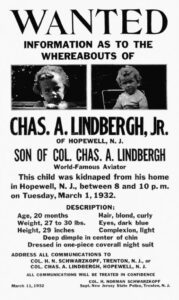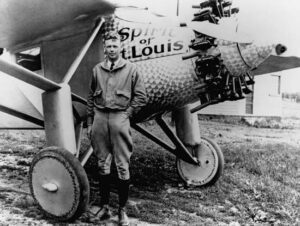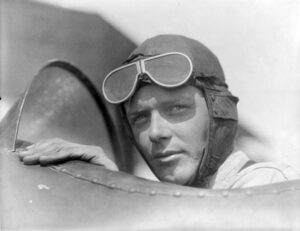Charles Lindbergh, a name synonymous with aviation, achieved worldwide fame for his historic transatlantic flight in 1927. However, his life was marked not only by soaring accomplishments but also by controversy, tragedy, and eventual redemption. In this blog post, we’ll explore the incredible journey of Charles Lindbergh, from his early successes to the infamous kidnapping case and his final days. 
The Aviator’s Ascent
Charles Lindbergh was born on February 4, 1902, in Detroit, Michigan. From a young age, he was fascinated with aviation and started taking flying lessons in 1922. His big break came in 1927 when he became the first person to fly nonstop from New York to Paris aboard the Spirit of St. Louis, a solo flight that catapulted him to international stardom and earned him the nickname “Lucky Lindy.” This feat brought him substantial wealth and fame.
The Kidnapping of the Charles Lindbergh Baby
On the night of March 1, 1932, Charles Lindbergh Jr., the 20-month-old son of Charles Lindbergh and Anne Morrow Lindbergh, was abducted from the family’s home in Hopewell, New Jersey. A ransom note demanding $50,000 was found in the child’s nursery, which triggered a massive manhunt and investigation.
The Lindberghs, along with their lawyer, followed the kidnapper’s instructions and paid the ransom, but tragically, despite their efforts, the baby was not returned. In May 1932, the child’s remains were discovered in a wooded area near the Lindbergh estate. An autopsy determined that the cause of death was a blow to the head.
The Investigation: The investigation into the kidnapping became a national obsession. The New Jersey State Police, led by Colonel H. Norman Schwarzkopf (father of the Gulf War general with the same name), worked tirelessly on the case. The FBI, then known as the Bureau of Investigation, also became involved, as kidnapping was a federal offense.
The case led to a nationwide manhunt, and thousands of leads were pursued. It was a major news story, capturing the public’s attention and generating enormous public sympathy for the Lindbergh family.
The Capture and Trial: In September 1934, two years after the kidnapping, a marked bill from the ransom payment was traced to Bruno Hauptmann, a German immigrant and carpenter living in the Bronx, New York. Hauptmann was arrested and subsequently charged with the kidnapping and murder of Charles Lindbergh Jr.
The trial of Bruno Hauptmann began on January 2, 1935, in Flemington, New Jersey. The case was highly publicized, with journalists from around the world covering the proceedings. Hauptmann maintained his innocence throughout the trial, claiming that he had no knowledge of the crime and that he had been given the ransom money by a friend named “Isidor Fisch” who had since returned to Germany and died.
The prosecution presented strong evidence against Hauptmann, including handwriting analysis that linked him to the ransom notes and the discovery of a substantial portion of the ransom money in his possession.
Hauptmann was found guilty of first-degree murder and sentenced to death in the electric chair. Despite maintaining his innocence to the end, he was executed on April 3, 1936, at the New Jersey State Prison.
The Lindbergh kidnapping and trial had a profound impact on American society. It led to changes in federal kidnapping laws, making it a federal crime with the potential for the death penalty, and it heightened concerns about the safety and privacy of public figures and their families. The case also solidified the role of forensic evidence, such as handwriting analysis, in criminal investigations and trials.
Controversial Views of Charles Lindbergh
Lindbergh’s life post-kidnapping was marked by controversy. He became a leading advocate for isolationism in the lead-up to World War II and even received the Order of the German Eagle from Adolf Hitler in 1938, a decision that tarnished his reputation. His views on eugenics and population control further divided public opinion, with some seeing him as a visionary and others as a bigot.
Later Years and Legacy
In the later years of his life, Lindbergh retreated from the public eye and focused on his family. He and his wife, Anne Morrow Lindbergh, had several more children and continued their adventures in aviation, exploration, and conservation. Lindbergh played a significant role in pioneering medical aviation, helping to develop air ambulances and medical evacuation systems.
Charles Lindbergh passed away on August 26, 1974, in Maui, Hawaii, at the age of 72. Despite the controversies that marred his life, he remains a key figure in aviation history, celebrated for his groundbreaking achievements in flight. His legacy also includes advancements in aviation technology and his contributions to environmental and medical causes.
Wrapping it all Up
Charles Lindbergh’s life was a complex tapestry of triumphs, tragedies, and controversies. From his historic transatlantic flight that made him an international sensation to the heartbreaking kidnapping of his son and his controversial views and actions, Lindbergh’s story is one of great highs and lows. Regardless of the controversies, his contributions to aviation and his pioneering spirit continue to shape the world of flight to this day, cementing his place in history as an iconic aviator. Next week it’s time to update our 2023 air travel event calendar, until then, Be Social, Fly Private!



